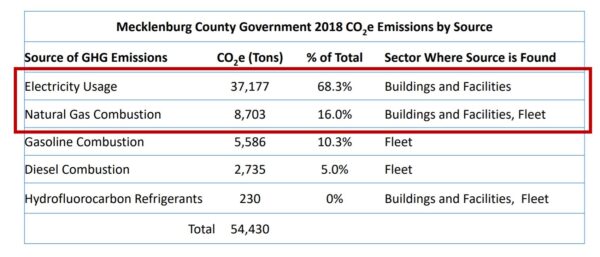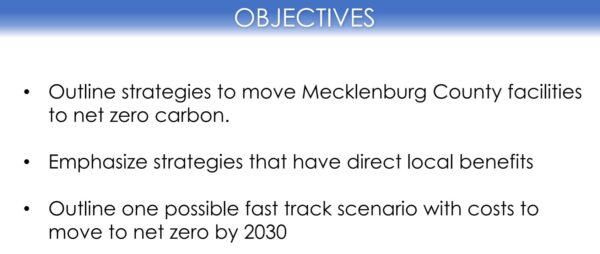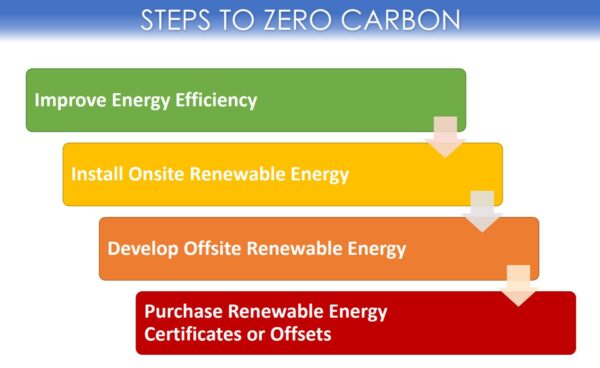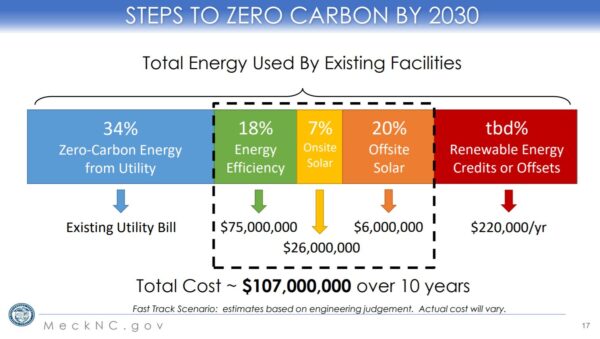Mecklenburg County is working to achieve zero-carbon buildings. Here’s how.
At the February 11 Environmental Stewardship Committee meeting, Mecklenburg County’s Energy Manager reviewed the current carbon footprint of the County’s buildings and how they’ll achieve zero-carbon status by 2030.

The majority of greenhouse gas emissions produced by Mecklenburg County government’s operations are a result of energy used in its facilities. As shown in the diagram above, 68.3% of greenhouse gas emissions are generated by electricity used in County buildings. 16% of emissions come from natural gas usage in both buildings and fleet (vehicles).
We’re really excited that the County is seriously focusing on the climate impact of its buildings. It’s their largest category of current greenhouse gas emissions, which means this is also their biggest opportunity to reduce those emissions.
Here are two important things to note as you read:
1. The figures presented here apply only to Mecklenburg County government facilities and operations. They don’t include energy usage by Mecklenburg residents, businesses, or Charlotte-Mecklenburg Schools.
2. The info presented here is for achieving zero-carbon for existing County buildings and facilities. All new County facilities would need to be built to net-zero standards. That will add about 25% to the standard project budgets for those buildings. Given the urgency of the global climate crisis, we believe it’s a vital investment, and one that must be made by a responsible government.
Here are the 3 major objectives of Mecklenburg County’s proposed energy strategy for buildings and facilities:

The County proposes to pursue four steps to achieve zero-carbon buildings:

Here’s the proposed “Fast Track” path to get there:

Let’s take a closer look at the diagram above.
Blue: 34% of current energy use in County buildings is derived from zero-carbon energy sources.
Green: 18% of the zero-carbon goal can be achieved by improving energy efficiency. This will require a lot of different strategies including more efficient lighting and equipment, retrofits of existing facilities, establishing energy/GHG goals for maintenance providers, transitioning to all electric heating sources whenever possible, upgrading building control systems w/ analytics, and enforcing energy conserving policies.
Yellow: 7% of the zero-carbon goal depends on adding Onsite solar energy on facility roofs and parking lots.
Orange: An additional 20% of the goal can be achieved through Offsite solar energy. This can be done through Duke Energy’s Greensource Advantage program that would allow offsite solar to meet up to 125% of the County’s electrical demand. Solar power generated offsite wouldn’t directly power County buildings. Instead it would feed into the regional power grid, which has the overall effect of “greening” the regional grid.
Red: A variable percentage of the goal could be achieved by purchasing renewable energy credits or offsets.
The estimated cost to achieve zero-carbon status for existing County facilities over the next 10 years is about $107,000,000. As mentioned above, building new facilities to be zero-carbon will add about 25% to their construction cost.
Is it worth it? Absolutely. The global impacts of climate change are already being felt across the world and are predicted to increase. The costs of climate change are already being felt in a very real way by NCDOT as increased maintenance costs across the state. The increasingly damaging and frequent weather events striking North Carolina are harming us as individuals and a society.
We’re proud of Mecklenburg County staff and elected officials for not only quantifying the carbon footprint for County operations, but also setting a time-bound goal and developing strategies to achieve a zero-carbon future!
All figures included in this article are from the presentation given by Mecklenburg County staff at this meeting. View the full presentation here.
Thanks for reading!
As a nonprofit, community support is essential for us to keep doing what we do — including providing free articles like this. If you found this article helpful, please consider supporting Sustain Charlotte.
Want to stay in the loop? Subscribe to our weekly newsletter and follow us on Instagram, Facebook, and Twitter.
